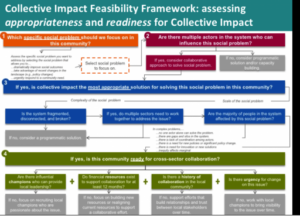In this webinar, Liz Weaver and Robert Albright from the Collective Impact Forum discuss Collective Impact’s utility as a method for problem-solving in complex situations. Collective Impact (CI) is the commitment of a group of important actors from across different sectors to a common agenda for addressing a specific complex problem at scale—the essence of Designing for Contribution.
Collective Impact posits that large scale collective change is achieved through five key elements:
- Establish a common agenda, including a common understanding of the problem and shared vision for change;
- Establish a shared measurement system for collecting data and measuring results;
- Utilize mutually reinforcing activities with differentiated approaches but coordinated through a joint plan of action;
- Ensure continuous communication, promoting openness and building trust;
- Resource for backbone support.
 The webinar illustrated the framework for assessing appropriateness and readiness for a Collective Impact approach. Enabling factors include: Influential Champions and Supportive Leadership who are able to bring together leaders across sectors; committed funding partners; a history of collaborative efforts in the community; and an urgency for change motivated by frustration with existing approaches/ a complex, multi-faceted problem facing the community. While CI does not necessitate all prerequisites to be met in advance of beginning a CI initiative, they should be helpful benchmarks in assessing readiness and appropriateness.
The webinar illustrated the framework for assessing appropriateness and readiness for a Collective Impact approach. Enabling factors include: Influential Champions and Supportive Leadership who are able to bring together leaders across sectors; committed funding partners; a history of collaborative efforts in the community; and an urgency for change motivated by frustration with existing approaches/ a complex, multi-faceted problem facing the community. While CI does not necessitate all prerequisites to be met in advance of beginning a CI initiative, they should be helpful benchmarks in assessing readiness and appropriateness.
Relatedly, CI recommends conducting a systems mapping at the early stages to identify existing tables for CI governance or opportunities for joint learning or sharing across collaboratives
